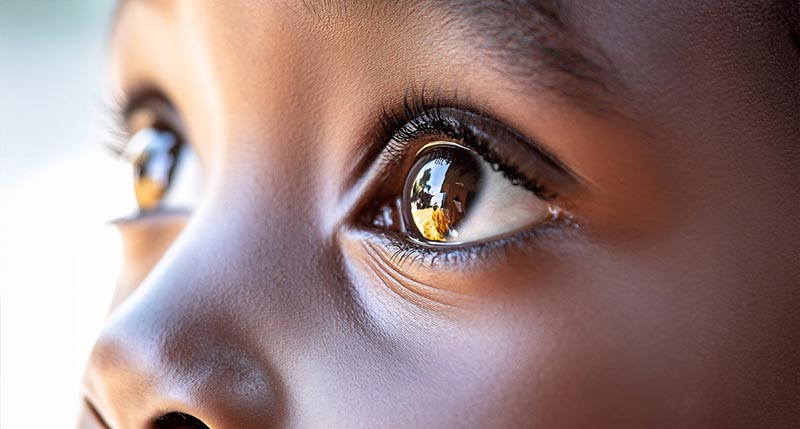As the new school year starts, student athletes begin focusing not only on academic success but also athletic excellence. The path to athletic distinction is more than physical strength and stamina; a student’s vision plays a critical role. Self-image depends on so many facets of a young athlete’s life, and performing well during athletic competition is a big one. So how does peripheral vision tie into it?
Did you know that 80% of what the brain processes while playing sports comes in visually, and much of that input is courtesy of your peripheral vision?
To understand why, let’s start at the beginning: We’ll define peripheral vision and look at the reason it’s so important.
What is Peripheral Vision?
Vision can be divided into two categories — central vision and peripheral vision.
- Central vision is what you see directly in front of you – the center of your vision field. It enables you to see clearly and in color. In a sporting situation, central vision is what enables athletes to connect the baseball bat to the baseball and get a base hit.
- Peripheral vision or visual awareness, simply stated, is everything you see from the side of the eye when looking forward without moving your head. It is the area of vision that starts about 3 degrees outside of your central vision and extends to nearly 180 degrees.
Why Does Peripheral Vision Matter in Sports?
Athletes — both student and professional — use peripheral vision to detect movement, and that visual sensing of movement is directly associated with anticipation and reaction speed in the brain. The brain also uses peripheral vision to differentiate between shapes, for example, a ball versus another player, before that object or player comes into the central visual field.
Peripheral vision is critically important, not only in your ability to detect and react to opportunities and improve anticipation, but also to prevent injury. The risk of injury increases significantly if an athlete can’t detect a potential hit approaching from the side or an unexpected change in play. Peripheral vision informs your student athlete with spatial awareness and may give them that fraction of a second longer to react — which can mean the difference between sustaining an injury or reacting to prevent one.
How Does Peripheral Vision Impact Students Playing School Sports?
Let’s take a look at how peripheral vision impacts specific sports, and how it enhances situational awareness and decision-making to give your student athlete a competitive edge.
- Soccer players constantly track the ball, opponents, and teammates while maintaining focus on the entire field. In order to make quick decisions – like spotting a defender’s movement from the side or locating an open teammate for a quick pass, peripheral vision is important in seeing the entire field.
- It’s a fast-paced sport, and the player must deliver “no-look” passes (that’s peripheral vision in action!), scan the court when dribbling, track opponents approaching for the steal, or orchestrate quick plays. Good peripheral vision is essential in all of these court skills.
- In a contact sport like football, peripheral vision can help athletes avoid collisions or brace for side impact by a fast-moving opponent, therefore reducing the potential for injury. Think about your quarterback sensing a hit from “the blind side,” or a receiver being hyperaware of the out-of-bounds line as he locates the ball coming toward him for a pass reception near the sideline.
- Baseball and Softball. Peripheral vision provides players with an overview of the whole playing field without turning their heads – so they can track how the ball and players move within the game. Peripheral vision is vitally important when deciding where to throw the ball, whether to run for the steal, or if you need to slide into home plate.
- Gymnastics. Peripheral vision empowers your student athlete to maintain spatial orientation while performing — particularly while flipping or leaping in mid-air. There is little room for error in fast-paced, precision routines, and reaction time is crucial.
What Happens When Peripheral Vision is Compromised?
Poor peripheral vision can lead to difficulty in tracking, on-field awareness, and can create obstacles that lead to reduced performance and possible injury. Without a healthy range of peripheral vision, your student athlete can experience a feeling of “tunnel vision” that blocks out part of the vision field.
How Can Parents Support Their Student Athlete’s Vision?
Do be aware of your student athlete’s “clues” — signs or behaviors that point to compromised vision. Have you noticed an increase in missed plays, mishandling the ball, newly acquired clumsiness, or even a growing disinterest in playing the sport? That can be a change in your student’s vision, and is likely fixable with the right visual correction.
Don’t depend on standard school eye screenings for your athlete’s eye care. These school screenings, typically administered by a school nurse or official rather than a trained and licensed optometrist, miss up to 75% of vision problems, and they often don’t screen for peripheral vision. Ultimately, such school screenings are not intended to replace a thorough professional eye exam.
Do call your optometrist and schedule a comprehensive eye exam today. Ask for a peripheral vision evaluation — along with tests for binocular vision and depth perception.
Our offices are staffed with vision professionals who care about your student athlete and their eyes. Our goal is to help them perform their best in every situation — both in the classroom and in the sports arena. We look forward to hearing their sports stories at their next annual eye exam!

